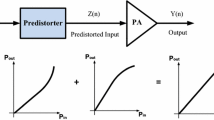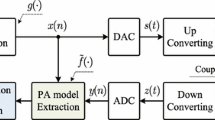Abstract
A novel identification and digital predistortion scheme of weakly nonlinear passband systems such as RF power amplifiers (PA) is presented. It is well known that for the identification of weakly nonlinear systems, despite the spectral regrowth, it suffices to sample the input-output (I/O) data of the system at the Nyquist rate of the input signal. Many applications such as linearization (digital predistortion) and mixed signal simulations require system models at a higher sampling rate than Nyquist. Up to now the construction of such high-rate predistorters has been done by oversampling the corresponding I/O data. This leads to high computational complexity, ill-posedness of the estimation, and high demand on the analog-to-digital converter (ADC) sampling rate for the implementation. This paper discusses an efficient way to obtain high-rate predistorters from low-rate system models and shows the validity of the proposed scheme for a 5th-order complex baseband PA model, where adjacent channel power suppression of 20 dB is achieved.










Similar content being viewed by others
References
Benedetto, S., Biglieri, E., & Daffara, R. (1979). Modeling and performance evaluation of nonlinear satellite links—a Volterra series approach. IEEE Transactions on Aerospace and Electronic Systems, 15, 494–507.
Benedetto, S., & Biglieri, E. (1999). Principles of digital transmission with wireless applications. Kluwer Academic/Plenium Publishers.
Cavers, J. K. (1989). Amplifier linearization using a digital predistorter with fast adaption and low memory requirenments. IEEE Transactions on Vehicular Technology, 37, 1885–1890.
Cripps, S. C. (1999). RF power amplifiers for wireless communications. Boston, London: Artech House.
Cripps, S. C. (2002). Advanced techniques in RF power amplifier design. Boston, London: Artech House.
Ding, L., Raich, R., & Zhou, G. T. (2002). A Hammerstein predistortion linearization design based on the indirect learning architecture. In IEEE International Conference on Acoustics, Speech, and Signal Processing, 2002. Proceedings. (ICASSP ’02), May 2002 (pp. 2689–2692).
Ding, L., Zhou, G. T., Morgan, D. R., Ma, Z., & Kenney, S. (2002). Memory polynomial predistorter based on the indirect learning architecture. In IEEE Global Telecommunications Conference GLOBECOM, Nov. 2002 (pp. 967–971).
Eun, C., & Powers, E. J. (1997). A new Volterra predistorter based on the indirect learning architecture. IEEE Transactions on Signal Processing, 45, 223–227.
Frank, W.A. (1996). Sampling requirements for Volterra system identification. IEEE Signal Processing Letters, 3, 266–268.
Gao, X. Y., & Snelgrove, W. M. (1990). Adaptive linearization schemes for weakly nonlinear systems using adaptive linear and nonlinear FIR filters. In IEEE Midwest Symposium on Circuits and Systems, Aug. 1990 (pp. 9–12).
Kennington, P. B. (2000). High linearity RF amplifier design. Boston, London: Artech House.
Mathews, V. J., & Sicuranza, G. L. (2000) Polynomial signal processing. John Wiley & Sons, INC.
Raich, R., Qian, H., & Zhou, G. T. (2003). Digital baseband predistortion of nonlinear power amplifiers using orthogonal polynomials. in IEEE International Conference on Acoustics, Speech, and Signal Processing, Proceedings. (ICASSP ’03), Apr. 2003 (pp. 689–692).
Rugh, W. J. (2002). Nonlinear system theory. The Johns Hopkins University Press.
Schetzen, M. (1980). The Volterra and Wiener theories of nonlinear systems. Malabar, Florida: Krieger Publishing Company.
Singerl, P., & Koeppl, H. (2005). Volterra kernel interpolation for system modeling and predistortion purposes. In IEEE International Symposium on Signals, Circuits and Systems (ISSCS) (Vol. 1, pp. 251–254). Iasi, Romania, July 2005.
Singerl, P., & Kubin, G. (2005) Chebyshev approximation of baseband Volterra series for wideband RF power amplifiers. In IEEE International Symposium on Circuits and Systems (ISCAS), (Vol. 3, pp. 2655–2658). Kobe, Japan.
Yeqing, Q., Qi, L., & Tianren, Y. (2003). Analysis of different predistortion structures and efficient least-square adaptive algorithms. in IEEE International Conference on Acoustics, Speech and Signal Processing, 2, 461–464.
Acknowledgment
The authors would like to thank D. Schwingshackl and C. Vogel from the Graz University of Technology for their helpful comments.
Author information
Authors and Affiliations
Corresponding author
Rights and permissions
About this article
Cite this article
Singerl, P., Koeppl, H. A low-rate identification method for digital predistorters based on Volterra kernel interpolation. Analog Integr Circ Sig Process 56, 107–115 (2008). https://doi.org/10.1007/s10470-007-9074-4
Received:
Accepted:
Published:
Issue Date:
DOI: https://doi.org/10.1007/s10470-007-9074-4




